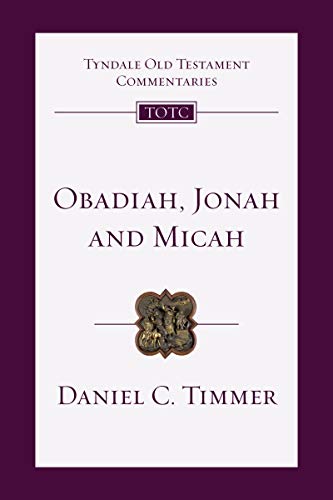A Book Review from Books At a Glance
by Riane K. McConnell
Daniel C. Timmer provides an excellent introduction to the three minor prophets in this Obadiah, Jonah, and Micah commentary. Timmer’s vision, explained in the preface, illustrates a theologically driven commentary embedded in historical and literary exegetical observations. In addition, he integrates current and new research to provoke further reflection by the reader.
Daniel C. Timmer serves as a professor of Biblical Studies at Puritan Reformed Theological Seminary in Grand Rapids, Michigan. He is an ordained elder in the Reformed Church of Quebec and serves at the Faculté de Théologie Évangélique in Montreal. Timmer’s personal theological devotion and expertise in the Old Testament text comprise the two pillars of this commentary
Although there are several commentaries written on the minor prophets—Obadiah (1–29), Jonah (p.31–83), and Micah (p.85–229)—Timmer offers a historical summary of each minor prophet proceeded by literary and syntactical observations that culminate in the books theological meaning. Each prophet is introduced by a summary of their historical setting, the book’s genre, approximate time of authorship, and brief comments on cultural matters. Timmer affords an overview of potentially conflictual historical arguments and rarely asserts an absolute position. It appears, that Timmer’s introduction serves as a way to introduce the reader to preliminary historical matters.
After introductory matters have been illustrated, Timmer formats each of the prophetic analyses slightly differently. The analysis of Obadiah is structured by an oracle. Each oracle is analyzed based on the oracle’s content, the author’s comments, and a summarized meaning of the oracle. The book of Jonah is comprised in a similar fashion as Timmer structures his analysis by Jonah’s two commissions (i.e., first commission: Jonah 1:1–2:10, and second commission: Jonah 3:1–4:11). Timmer’s analysis of Jonah takes a more narratival approach as he focuses on characters, the narrator, and plot. Timmer concludes the analysis of Jonah by illustrating how a literary and narratival approach provides deeper meaning into this book.
The last prophet of Timmer’s commentary is Micah. Following the preceding format of Obadiah and Jonah, the introduction to Micah is comprised of historical issues and comments. Timmer structure’s the analysis of Micah by cycle (i.e., Micah’s first cycle: Micah 1:1–2:13, second cycle: 3:1–5:15, and third cycle:6:1–7:20). However, Timmer’s attention to Micah appears more significant. Not only does Micah receive a significantly longer analysis as seen in the page count, but can also be attributed to his translation of Micah prior to the analysis section and his verse-by-verse comments which Obadiah and Micah did not receive. In Timmer’s analysis of Micah, he increases his syntactical and morphological observations and incorporates tables that illustrate structural pictures comprising his analysis. Timmer’s analysis of Micah is not only significant in size but in content as he integrates additional literary components that progress to a more thorough conclusion.
To conclude, Timmer provides a thorough introduction to the historical foundation of Obadiah, Jonah, and Micah, alongside his integration of exegetical notes, literary concerns, and theological reflections. This commentary would be an excellent introduction recommended to undergraduate students, ecclesial persons, and/or those interested in a theological introduction to these three minor prophets.
Riane K. McConnell is a Master of Arts student in Old Testament and Semitic Languages at Trinity Evangelical Divinity School (Deerfield, Illinois).
